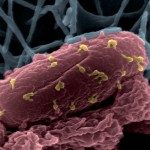Link to Pubmed [PMID] – 9724776
Proc. Natl. Acad. Sci. U.S.A. 1998 Sep;95(18):10751-6
Thioredoxin 1 is a major thiol-disulfide oxidoreductase in the cytoplasm of Escherichia coli. One of its functions is presumed to be the reduction of the disulfide bond in the active site of the essential enzyme ribonucleotide reductase. Thioredoxin 1 is kept in a reduced state by thioredoxin reductase. In a thioredoxin reductase null mutant however, most of thioredoxin 1 is in the oxidized form; recent reports have suggested that this oxidized form might promote disulfide bond formation in vivo. In the Escherichia coli periplasm, the protein disulfide isomerase DsbC is maintained in the reduced and active state by the membrane protein DsbD. In a dsbD null mutant, DsbC accumulates in the oxidized form. This oxidized form is then able to promote disulfide bond formation. In both these cases, the inversion of the function of these thiol oxidoreductases appears to be due to an altered redox balance of the environment in which they find themselves. Here, we show that thioredoxin 1 attached to the alkaline phosphatase signal sequence can be exported into the E. coli periplasm. In this new environment for thioredoxin 1, we show that thioredoxin 1 can promote disulfide bond formation and, therefore, partially complement a dsbA strain defective for disulfide bond formation. Thus, we provide evidence that by changing the location of thioredoxin 1 from cytoplasm to periplasm, we change its function from a reductant to an oxidant. We conclude that the in vivo redox function of thioredoxin 1 depends on the redox environment in which it is localized.

